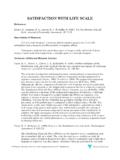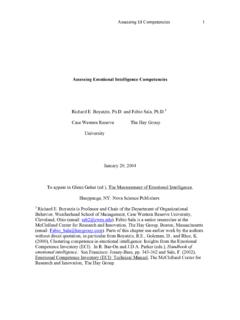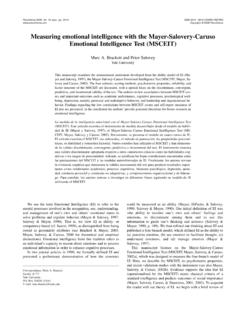Transcription of SATISFACTION WITH LIFE SCALE - 香港社會服務聯會
1 Self Report Measures for Love and Compassion Research: SATISFACTION SATISFACTION with life SCALE Reference: Diener, E., Emmons, R. A., Larsen, R. J., & Griffin, S. (1985). The SATISFACTION with life SCALE . Journal of Personality Assessment, 49, 71-75. Description of Measure: A 5-item SCALE designed to measure global cognitive judgments of one s life SATISFACTION (not a measure of either positive or negative affect). Participants indicate how much they agree or disagree with each of the 5 items using a 7-point SCALE that ranges from 7 strongly agree to 1 strongly disagree. Abstracts of Selected Related Articles: Pavot, W. G., Diener, E., Colvin, C. R., & Sandvik, E. (1991). Further validation of the SATISFACTION with life SCALE : Evidence for the cross-method convergence of well-being measures. Journal of Personality Assessment, 57, 149-161. The structure of subjective well-being has been conceptualized as consisting of two major components: the emotional or affective component and the judgmental or cognitive component (Diener, 1984; Veenhoven, 1984).
2 The judgmental component has also been conceptualized as life SATISFACTION (Andrews & Withey, 1976). Although the affective component of subjective well-being has received considerable attention from researchers, the judgmental component has been relatively neglected. The SATISFACTION with life SCALE (SWLS; Diener, Emmnos, Larsen, & Griffin, 1985) was developed as a measure of the judgmental component of subjective well-being (SWB). Two studies designed to validate further the SWLS are reported. Peer reports, a memory measure, and clinical ratings are used as external criteria for validation. Evidence for the reliability and predictive validity of the SWLS is presented, and its performance is compared to other related scales. The SWLS is shown to be a valid and reliable measure of life SATISFACTION , suited for use with a wide range of age groups and applications, which makes possible the savings of interview time and resources compared to many measures of life SATISFACTION .
3 In addition, the high convergence of self- and peer-reported measures of subjective well-being and life SATISFACTION provide strong evidence that subjective well-being is a relatively global and stable phenomenon, not simply a momentary judgment based on fleeting influences. Pavot, W. G., & Diener, E. (1993). Review of the SATISFACTION with life SCALE . Psychological Assessment, 5, 164-172. The SATISFACTION with life SCALE (SWLS) was developed to assess SATISFACTION with the respondent's life as a whole. The SCALE does not assess SATISFACTION with life domains such as health or finances but allows subjects to integrate and weight these domains in whatever way they choose. Normative data are presented for the SCALE , Self Report Measures for Love and Compassion Research: SATISFACTION which shows good convergent validity with other scales and with other types of assessments of subjective well-being.
4 life SATISFACTION as assessed by the SWLS shows a degree of temporal stability ( , .54 for 4 years), yet the SWLS has shown sufficient sensitivity to be potentially valuable to detect change in life SATISFACTION during the course of clinical intervention. Further, the SCALE shows discriminant validity from emotional well-being measures. The SWLS is recommended as a complement to scales that focus on psychopathology or emotional well-being because it assesses an individuals' conscious evaluative judgment of his or her life by using the person's own criteria. Diener, E., Sandvik, E., Seidlitz L., Diener, M. (1993). The relationship between income subjective well-being: Relative or absolute? Social Indicators Research, 28, 195-223. Although it appears that income and subjective well-being correlate in within-country studies (Diener, 1984), a debate has focused on whether this relationship is relative (Easterlin, 1974) or absolute (Veenhoven, 1988, 1991).
5 The absolute argument advanced by Veenhoven states that income helps individuals meet certain universal needs and therefore that income, at least at lower levels, is a cause of subjective well-being. The relativity argument is based on the idea that the impact of income or other resources depends on changeable standards such as those derived from expectancies, habituation levels, and social comparisons. Two studies which empirically examine these positions are presented: one based on 18 032 college studies in 39 countries, and one based on 10 year longitudinal data in a probability sample of 4 942 American adults. Modest but significant correlations were found in the between income and well-being, but the cross-country correlations were larger. No evidence for the influence of relative standards on income was found: (1) Income change did not produce effects beyond the effect of income level per se, (2) African-Americans and the poorly educated did not derive greater happiness from specific levels of income, (3) Income produced the same levels of happiness in poorer and richer areas of the , and (4) Affluence correlated with subjective well-being both across countries and within the Income appeared to produce lesser increases in subjective well-being at higher income levels in the , but this pattern was not evident across countries.
6 Conceptual and empirical questions about the universal needs position are noted. Suggestions for further explorations of the relativistic position are offered. Self Report Measures for Love and Compassion Research: SATISFACTION SCALE : Instructions: Below are five statements that you may agree or disagree with . Using the 1 - 7 SCALE below, indicate your agreement with each item by placing the appropriate number on the line preceding that item. Please be open and honest in your responding. 7 - Strongly agree 6 - Agree 5 - Slightly agree 4 - Neither agree nor disagree 3 - Slightly disagree 2 - Disagree 1 - Strongly disagree ____ In most ways my life is close to my ideal. ____ The conditions of my life are excellent. ____ I am satisfied with my life . ____ So far I have gotten the important things I want in life . ____ If I could live my life over, I would change almost nothing.
7 Scoring: Though scoring should be kept continuous (sum up scores on each item), here are some cut-offs to be used as benchmarks. 31 - 35 Extremely satisfied 26 - 30 Satisfied 21 - 25 Slightly satisfied 20 Neutral 15 - 19 Slightly dissatisfied 10 - 14 Dissatisfied 5 - 9 Extremely dissatisfied Self Report Measures for Love and Compassion Research: SATISFACTION SUBJECTIVE HAPPINESS SCALE (also known as General Happiness SCALE ) Reference: Lyubomirsky, S. & Lepper, H. S. (1999). A measure of subjective happiness: Preliminary reliability and construct validation. Social Indicators Research, 46, 137-155. Description of Measure: A 4-item SCALE designed to measure subjective happiness. Each of item is completed by choosing one of 7 options that finish a given sentence fragment. The options are different for each of the four questions (see below for actual items).
8 Abstracts of Selected Related Articles: Lyubomirsky, S. & Tucker, K. L. (1998). Implications of Individual Differences in Subjective Happiness for Perceiving, Interpreting, and Thinking About life Events. Motivation and Emotion, 22, 155-186. Both anecdotal and empirical evidence suggest that characteristically happy and daily situations. This paper reports two questionnaire studies and a laboratory study testing the hypothesis that happy people perceive, interpret, and think about the same events in more positive ways than do unhappy ones. The results of Study 1 showed that students nominated by their peers as "very happy" reported experiencing similar types of both positive and negative life events, as did peer-nominated "unhappy" students. However, self-rated happy students tended to think about both types of events more favorably and adaptively , by seeing humor in adversity and emphasizing recent improvement in their lives.
9 This pattern of results was conceptually replicated in Study 2 using hypothetical events. In Study 3, self-rated happy students interacted with a female confederate in the laboratory, then watched a series of videotapes depicting a fellow (but unfamiliar) student in three different situations. Happy individuals liked the person they met, and recalled her in more favorable terms, more than did unhappy ones. The same pattern of results, albeit weaker, was found for liking of the videotaped target. Implications of our findings for the question of how happiness (or unhappiness) is maintained are discussed. Seligman, M. E. P., Steen, T. A., Park, N., & Peterson, C. (2005). Positive psychology progress: Empirical validation of interventions. American Psychologist, 60, 410-421. Positive psychology has flourished in the last 5 years. The authors review recent developments in the field, including books, meetings, courses, and conferences.
10 They also discuss the newly created classification of character strengths and virtues, a positive complement to the various editions of the Diagnostic and Statistical Manual of Mental Disorders (e. g., American Psychiatric Association, 1994), and present some cross-cultural findings that suggest a surprising ubiquity of strengths and virtues. Finally, the authors focus on psychological interventions that increase individual happiness. In a 6-group, random-assignment, placebo controlled Internet Self Report Measures for Love and Compassion Research: SATISFACTION study, the authors tested 5 purported happiness interventions and 1 plausible control exercise. They found that 3 of the interventions lastingly increased happiness and decreased depressive symptoms. Positive interventions can supplement traditional interventions that relieve suffering and may someday be the practical legacy of positive psychology.







